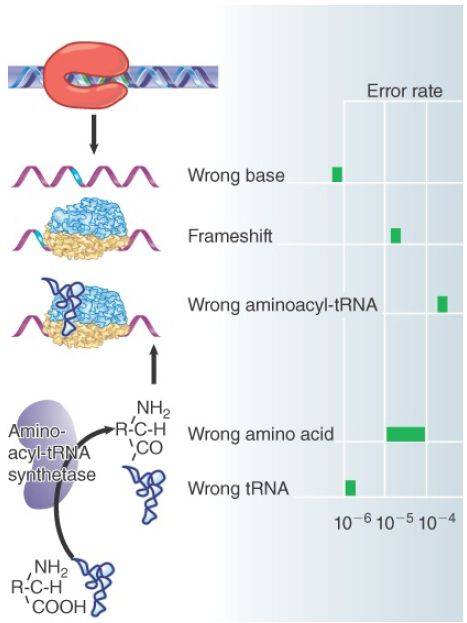
Special Mechanisms Control the Accuracy of Translation
 المؤلف:
JOCELYN E. KREBS, ELLIOTT S. GOLDSTEIN and STEPHEN T. KILPATRICK
المؤلف:
JOCELYN E. KREBS, ELLIOTT S. GOLDSTEIN and STEPHEN T. KILPATRICK
 المصدر:
LEWIN’S GENES XII
المصدر:
LEWIN’S GENES XII
 الجزء والصفحة:
الجزء والصفحة:
 23-5-2021
23-5-2021
 2015
2015
Special Mechanisms Control the Accuracy of Translation
KEY CONCEPT
- The accuracy of translation is controlled by specific mechanisms at each stage.
The general accuracy of translation is confirmed by the consistency that is found when determining the amino acid sequence of a polypeptide. Few detailed measurements of the error rate in vivo are available, but it is generally thought to be in the range of one error for every 104 to 105 amino acids incorporated. Considering that most polypeptides are produced in large quantities, this means that the error rate is too low to have much effect on the phenotype of the cell.
It is not immediately obvious how such a low error rate is achieved. In fact, an error can be made at several steps in gene expression:
-The enzymes that synthesize RNA may insert a base that is not complementary to the base on the template strand.
- Synthetases may attach the wrong tRNA to an amino acid or the wrong amino acid to a tRNA.
- A ribosome may allow binding of a tRNA that does not correspond to the codon in the A site.
Each case represents a similar problem for the mechanism: how to distinguish one particular member from the entire set, all of which share the same general features.
Probably any substrate can initially contact the active center by a random-hit process, but then the wrong substrates are rejected and only the correct one is accepted. The correct substrate is always rare (e.g., 1 of 4 bases, 1 of 20 amino acids, 1 of about 30 to 50 tRNAs), so the criteria for discrimination must be strict. The point is that the enzyme or ribozyme must have some mechanism for discriminating among substrates that are structurally very similar.
Figure 1 summarizes the error rates at the steps that can affect the accuracy of translation. Errors in transcribing mRNA are rare, probably less than 10−6 . This is an important stage for accuracy because a single mRNA molecule can be translated into many polypeptide copies. The mechanisms that ensure transcriptional accuracy are discussed in the chapter titled Prokaryotic Transcription.

FIGURE 1. Errors occur at rates ranging from 10−6 to 5 × 10−4 at different stages of translation.
The ribosome can make two types of errors in translation. It may cause a frameshift by skipping a base when it reads the mRNA (or, in the reverse direction, by reading a base twice—once as the last base of one codon, and then again as the first base of the next codon or twice within the same codon). These errors are rare, occurring at a rate of about 10−5 . Or, it may allow an incorrect aminoacyl-tRNA to (mis)pair with a codon, so that the wrong amino acid is incorporated. This is probably the most common error in translation, occurring at a rate of about 5 × 10−4 . This rate is determined by ribosome structure and dissociation kinetics .
An aminoacyl-tRNA synthetase can make two types of errors: It can place the wrong amino acid on its tRNA, or it can charge its amino acid with the wrong tRNA . The incorporation of the wrong amino acid is more common, probably because the tRNA offers a larger surface with which the enzyme can make many more contacts to ensur especificity. Aminoacyl-tRNA synthetases have specific mechanisms to correct errors before a mischarged tRNA is released .
 الاكثر قراءة في مواضيع عامة في الاحياء الجزيئي
الاكثر قراءة في مواضيع عامة في الاحياء الجزيئي
 اخر الاخبار
اخر الاخبار
اخبار العتبة العباسية المقدسة


